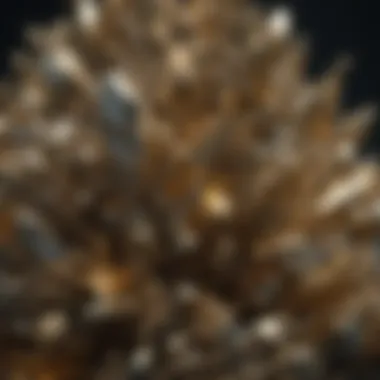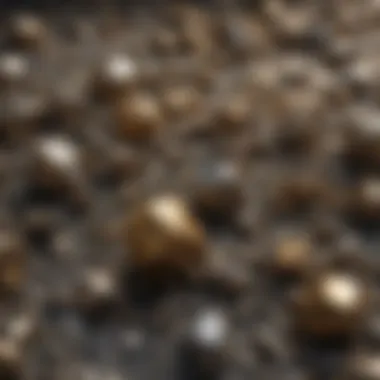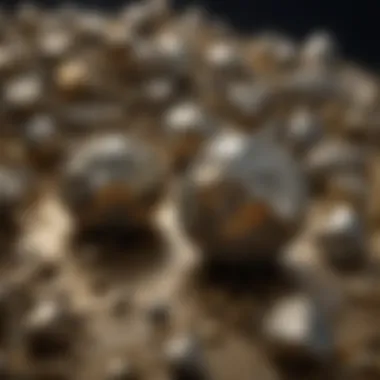Unveiling the Intriguing Beauty of Iron Pyrite Crystals: A Comprehensive Exploration


Rock and Fossil Identification
Iron pyrite crystals, with their radiant golden sheen and cubic formations, stand out as captivating specimens in the world of minerals. These crystals are classified as minerals, specifically as a type of sulfide mineral. One distinctive characteristic of iron pyrite is its metallic luster and brass-yellow hue, often mistaken for real gold due to its appearance. When identifying iron pyrite crystals, collectors should focus on its cubic structure and brassy coloration, distinguishing them from other minerals. Tools commonly used for identification include a hardness testing kit to determine its Mohs hardness scale rating and a streak plate to analyze its streak color.
Collecting Tips and Techniques
For avid collectors seeking to add iron pyrite crystals to their collection, it is essential to navigate the terrain with precision. Prime collecting sites often include areas rich in sulfide minerals and iron deposits such as abandoned mines, quarries, or regions with volcanic activity. Safety measures should be prioritized, with collectors advised to wear protective gear such as gloves and goggles to extract specimens without injury. Extraction techniques vary but may include using rock hammers and chisels to carefully dislodge crystals embedded in rock formations.
Preservation and Display
Preserving the pristine beauty of iron pyrite crystals requires proper techniques to prevent oxidation or degradation. Collectors can utilize methods such as coating the crystals with a clear sealant to maintain their luster and protect them from environmental factors that may lead to discoloration. Storing these specimens in a moisture-free environment, away from direct sunlight, helps prolong their appearance. Creative display ideas for showcasing iron pyrite crystals include mounting them on mineral stands or arranging them in shadow boxes to highlight their intricate formations.
Geological Insights
Exploring the geological origins of iron pyrite crystals unveils a rich history dating back millions of years. These crystals are typically found in sedimentary rock formations, formed through hydrothermal processes involving sulfur-rich fluids interacting with iron minerals. Historically, iron pyrite has been used in various cultural practices and as a source of ignition in early firearms. Notable discoveries of iron pyrite crystals in geological formations continue to contribute to our understanding of Earth's mineral diversity and its significance in scientific research.
Introduction
In the realm of mineralogy, iron pyrite crystals stand out as compelling geological wonders that have captivated humans for centuries. This article embarks on a fascinating journey into the enigmatic beauty of iron pyrite crystals, shedding light on their intricate formations, distinctive properties, and the profound allure they hold for rock and fossil collectors worldwide.
Iron pyrite, also known as "Fool's Gold," possesses a magnetic charm that has sparked the curiosity of geologists, gemologists, and collectors alike. Its shimmering golden hue and geometric shapes evoke a sense of mystery and fascination, making it a prized addition to any collection of minerals and gems.


Exploring the geological origins of iron pyrite crystals unveils a tale as old as time, with these crystals forming deep within the Earth's crust under intense pressure and heat. Understanding the geological processes that give rise to these mesmerizing specimens adds a layer of appreciation for their beauty and rarity.
Moreover, delving into the crystal structure of iron pyrite unveils a symphony of intersecting cubic shapes and metallic luster, creating a visual spectacle that is both breathtaking and scientifically intriguing. The unique atomic arrangement within each crystal grants iron pyrite its distinct properties, setting it apart from other minerals in the mineral kingdom.
Throughout this comprehensive guide, we will navigate the formation process of iron pyrite crystals, unraveling the intricacies of how these geological marvels take shape over millennia. By dissecting the complex interactions of minerals and elements during the crystal growth phase, we gain a deeper understanding of the forces at play in creating these alluring specimens.
Join us on a voyage through the mesmerizing world of iron pyrite crystals, where science, beauty, and history converge to create a tapestry of wonder and fascination. Whether you are a seasoned collector or a curious enthusiast, this exploration promises to unveil the hidden secrets and allure of one of nature's most charismatic creations.
The Formation of Iron Pyrite Crystals
Iron pyrite crystals, also known as fool's gold, are a fascinating subject of study due to their alluring beauty and unique properties. Understanding the formation of iron pyrite crystals is essential to appreciating their geological significance and cultural allure. This section delves deep into the intricate processes that lead to the creation of these enigmatic crystals, shedding light on their geological origins, crystal structure, and formation process.
Geological Origins
The geological origins of iron pyrite crystals can be traced back to a variety of environments rich in sulfide minerals. These crystals often form in sedimentary rocks, hydrothermal veins, and metamorphic rocks, where high concentrations of iron and sulfur are present. The process begins with the precipitation of iron and sulfur compounds from hydrothermal fluids or the alteration of pre-existing minerals like marcasite. Over time, under the right conditions of pressure and temperature, these precipitates undergo transformation, leading to the crystallization of iron pyrite. The geological history and tectonic activities of a region play a crucial role in determining the formation of iron pyrite crystals, making each specimen a unique geological artifact.
Crystal Structure
The crystal structure of iron pyrite is a key factor in its distinctive appearance and properties. Iron pyrite belongs to the cubic crystal system, typically forming in the isometric-hexoctahedral class. The crystals exhibit symmetrical geometric patterns with well-defined faces and edges, giving them a captivating visual appeal. At the atomic level, iron pyrite crystals consist of iron ions coordinated with sulfur ions in a cubic closest-packing arrangement. This arrangement accounts for the metallic luster and golden hue that are characteristic of iron pyrite crystals. Understanding the crystal structure of iron pyrite is crucial for assessing its physical and chemical properties, making it a fundamental aspect of mineralogical research.
Formation Process


The formation process of iron pyrite crystals involves a series of complex geochemical reactions that take place over extended periods. When sulfur-rich fluids interact with iron-bearing minerals in the presence of reducing conditions, the stage is set for iron pyrite formation. This process often occurs in an anoxic environment where organic matter contributes to the reduction of sulfur compounds, facilitating the growth of iron pyrite crystals. Factors such as temperature, pressure, p H levels, and the availability of reactant minerals influence the rate and scale of crystal formation. Studying the formation process of iron pyrite provides valuable insights into Earth's geological processes and the conditions that give rise to these captivating crystals.
Physical Characteristics
Iron pyrite crystals exhibit a fascinating array of physical characteristics that contribute to their enigmatic beauty and allure. Understanding these attributes is crucial for collectors and enthusiasts to appreciate the unique properties of these crystals fully. The examination of physical characteristics such as color, luster, and hardness provides valuable insights into the quality and worth of iron pyrite specimens. Through detailed analysis and observation, collectors can discern the intricate details and variations that make each crystal distinct and captivating.
Color and Luster
The color and luster of iron pyrite crystals play a pivotal role in their aesthetic appeal and desirability within the realm of mineral collection. Iron pyrite typically displays a striking metallic yellow hue, contributing to its nickname "fool's gold." The luster of these crystals is predominantly metallic, imparting a brilliant sheen that catches the light and enhances their visual appeal. The interplay of color and luster in iron pyrite crystals creates a mesmerizing effect, captivating the observer with its iridescent qualities and reflective surfaces.
Mohs Hardness Scale
The Mohs hardness scale is a crucial parameter for evaluating the durability and resistance of minerals such as iron pyrite. With a hardness rating of 6 to 6.5 on the Mohs scale, iron pyrite demonstrates moderate to relatively high hardness, making it resilient to scratches and abrasions. This characteristic ensures that iron pyrite crystals maintain their integrity and beauty over time, making them ideal for display and collection. By understanding the Mohs hardness scale, collectors can assess the durability of iron pyrite specimens and make informed decisions regarding their care and handling.
Unique Properties
Iron pyrite crystals possess a range of unique properties that set them apart from other minerals and gemstones. One of the most notable properties of iron pyrite is its cubic crystal structure, which contributes to its distinctive shape and formation. Additionally, iron pyrite exhibits a metallic luster and opaque clarity, further enhancing its allure and visual appeal. The pyritohedral growth patterns often seen in iron pyrite crystals add an element of complexity and beauty, showcasing the intricate structures that nature can create. These unique properties make iron pyrite a sought-after collectible for both its aesthetic charm and geological significance.
Cultural Significance
Iron Pyrite crystals hold a significant place in cultural history, revered for their mystique and aesthetic appeal. Across various civilizations, these crystals have symbolized wealth, prosperity, and protection due to their resemblance to precious metals like gold. The cultural significance of Iron Pyrite extends to its perceived metaphysical properties, believed to attract abundance and positive energy. In ancient times, pyrite was often used in medicinal practices and spiritual rituals, highlighting its versatile role beyond material wealth. Collectors and enthusiasts value Iron Pyrite not only for its physical beauty but also for the cultural meanings embedded within its iridescent surface.


Historical Uses
Iron Pyrite, also known as 'Fool's Gold,' has a rich history of practical applications. From the Bronze Age to modern times, pyrite has been utilized for various purposes such as creating sparks for fire-making or as an early form of currency. In the Middle Ages, pyrite was valued for its perceived alchemical properties, believed to transmute base metals into gold. Historically, Iron Pyrite has been a symbol of deception due to its resemblance to gold, hence its moniker 'Fool's Gold'. Despite its deceptive nature, the historical uses of Iron Pyrite showcase its enduring appeal and utility throughout different epochs.
Symbolism and Folklore
The symbolism surrounding Iron Pyrite is deeply rooted in folklore and mythology, captivating storytellers and historians alike. Commonly associated with the sun and fire elements, Iron Pyrite is believed to radiate positive energy and vitality. In folklore, pyrite's reflective surface has been linked to divination practices, guiding individuals towards inner wisdom and clarity. The protective properties of Iron Pyrite have led to its association with warding off negative energies and promoting mental acuity. Across cultures, Iron Pyrite's symbolic significance transcends time, making it a cherished symbol of resilience and strength in the face of adversity.
Collecting and Preserving
Iron pyrite crystals hold a special place in the hearts of collectors and enthusiasts due to their mesmerizing beauty and unique properties. The section focusing on Collecting and Preserving in this comprehensive guide plays a pivotal role in educating individuals on the importance of responsible collection practices and proper preservation techniques. Understanding the significance of these aspects is crucial for maintaining the integrity and value of iron pyrite specimens over time. By delving into the principles of ethical collecting and effective preservation methods, rock and fossil enthusiasts can safeguard their precious pyrite crystals for generations to come.
Tips for Collectors
For avid collectors seeking to enhance their iron pyrite crystal collection, a few essential tips can make a significant difference. Firstly, it is paramount to research and identify reputable sources for acquiring genuine pyrite specimens to avoid counterfeit or misrepresented pieces. Secondly, diversifying the collection by acquiring specimens from various geological locations can provide a comprehensive view of the crystal's diversity. Lastly, documenting the collection with detailed information about each specimen's origin, characteristics, and acquisition history adds value and facilitates future identification and research.
Preservation Techniques
Preserving the inherent beauty and integrity of iron pyrite crystals requires adherence to specific techniques to prevent deterioration or damage. One effective preservation method is storing the crystals in a controlled environment with stable temperature and humidity levels to mitigate external factors that could degrade the specimen. Additionally, utilizing archival-quality display cases or storage containers helps protect the crystals from dust, moisture, and physical harm. Implementing gentle cleaning practices using soft brushes or compressed air can remove surface debris without damaging the delicate crystal structure, ensuring lasting beauty and longevity for the collection.
Notable Locations
When it comes to exploring the world of iron pyrite crystals, diving into the realm of notable locations where these captivating crystals can be found is an important aspect of any enthusiast’s journey. These locations serve as rich hubs of geological wonders, offering a glimpse into the natural formations and occurrences of iron pyrite crystals that truly showcase their beauty in its raw form.
One particularly notable location for iron pyrite crystals is the Navajún Mine in Spain. Renowned for its exceptional pyrite cubes, this mine has gained fame among collectors and geologists alike for the quality and distinctive structure of the crystals found here. The geometric precision of the pyrite cubes from Navajún is a marvel to behold, with pristine formations that attract collectors from around the globe in search of these unique specimens.
Another significant site for iron pyrite enthusiasts is the Huanzala Mine in Peru. Here, iridescent pyrite crystals with a rainbow-like sheen can be discovered, adding a touch of ethereal beauty to the already mesmerizing crystals. The Huanzala Mine stands out for its strikingly colorful pyrite specimens, making it a must-visit destination for those looking to marvel at the diverse spectrum of hues that iron pyrite can exhibit.
Moving towards North America, the Sweet Home Mine in Colorado is another iconic location where iron pyrite crystals showcase their enchanting allure. Often found in association with other minerals like quartz, the pyrite crystals from this mine possess a unique charm, with their golden gleam and intricate crystal structures. Collectors flock to the Sweet Home Mine to witness firsthand the harmonious coexistence of different minerals within a single specimen, highlighting the geological complexity and beauty of iron pyrite.







